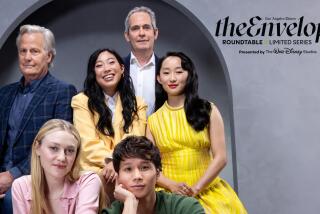Classic Hollywood: Charlie Chaplin’s goodbye to Hollywood
- Share via
Charlie Chaplin was in great spirits during the production of his 1952 film “Limelight,” his first film since his poorly received 1947 dark comedy, “Monsieur Verdoux. “ “Limelight,” turned out to be Chaplin’s final Hollywood film — and it brought back memories of the legendary actor and filmmaker’s glory days.
“He was like the young Charlie. I would sit in his old-time dressing room being made up with him and he was full of fire,” said his friend, actor Norman Lloyd, who appears as a choreographer in the sentimental drama about a once famous clown named Calvero, who prevents troubled young ballerina Thereza (Claire Bloom) from killing herself, nurses her back to health and rekindles her desire to live.
Lloyd and Bloom will be on hand to reminisce about the making of “Limelight” at a screening Wednesday evening at the Samuel Goldwyn Theater of the Academy of Motion Picture Arts and Sciences. The film also features Chaplin and Buster Keaton performing a bit involving a piano and violin.
Full coverage: Classic Hollywood
“Limelight” was a family affair for Chaplin. His son Sydney made his film debut as Neville, a composer and love interest of Thereza. Chaplin’s young wife, Oona, and their children Geraldine, Michael and Josephine also appeared in the film, as did his adult son Charles Chaplin Jr.
The film came out at the height of the Red Scare in the U.S. and Chaplin, whose liberal politics were widely known, became a target of the communist witch hunt in Hollywood. “Limelight” was basically banned for 20 years in the U.S. and didn’t open in Los Angeles until 1972. (Chaplin, Raymond Rasch and Larry Russell won the 1972 Oscar for score).
Chaplin had incurred the wrath of FBI director J. Edgar Hoover when he canceled scheduled appearances at the House Committee on Un-American Activities. He had already aroused suspicion by retaining his British citizenship, even though he had lived and worked in Hollywood since the teens when he became a comedic sensation as the baggy pants “Little Tramp” character in shorts and in such classic feature comedies as 1921’s “The Kid,” 1925’s “The Gold Rush,” 1931’s “City Lights” and 1936’s “Modern Times.”
When he and his family got ready to sail to London in October 1952 for the world premiere of “Limelight,” Chaplin had problems getting a re-entry permit from the U.S. He finally obtained one, but it was revoked on his way back. Chaplin and his family eventually moved to Switzerland.
Lloyd said that when Chaplin learned that he wouldn’t be allowed to go back to the U.S. “he said he would never make another picture in America. And he never did.”
Most people in Hollywood doubted that Chaplin was a communist, according to Lloyd.
“There’s a story that they asked [producer] Samuel Goldwyn if Charlie was a communist. And Goldwyn said, ‘Charlie a communist? He is the only true capitalist I know,’ ” Lloyd recalled.
Bloom was just 19 when Chaplin cast her in the film. She had been spotted by playwright Arthur Laurents, who had seen her play a ballerina in the London stage in “Ring Around the Moon,” and he recommended her to Chaplin. “I did send photographs,” said Bloom. Four months later, she learned she had the job and came to Hollywood accompanied by her mother.
“He was absolutely wonderful to me,” Bloom said of Chaplin. He was also very meticulous in his directing of her and Sydney, making sure every gesture, every moment was right.
“I was 19 and certainly knew nothing about film and nothing about anything much,” she said. “I was delighted Chaplin told me what to do.”
Though she had no scenes with Keaton, she made sure she was on the set to observe these two comedy giants at work. “He didn’t really talk to anyone,” she recalled of Keaton. “The only thing he ever said to me is that he passed a postcard to me of a lovely big, kind of rambling Los Angeles house and said, ‘This used to be where I lived.’ He didn’t seem like he was a very happy man.”
“Limelight,” said Bloom, was a very personal film for Chaplin, who had grown up and began his career in the music hall era that is depicted in the film. “It also had to do with his love for Oona.”
“You have this great universal artist reflecting upon his past,” said Randy Haberkamp, the academy’s managing director for programming, education and preservation. “It is not the Little Tramp. It is not about the shoes, the hat and the cane, it is about the real person inside of those things.”
For information on the screening, go to https://www.oscars.org.
Are you an aficionado of iconic Hollywood? Like our Classic Hollywood Facebook page to get more Times coverage.
More to Read
Only good movies
Get the Indie Focus newsletter, Mark Olsen's weekly guide to the world of cinema.
You may occasionally receive promotional content from the Los Angeles Times.











